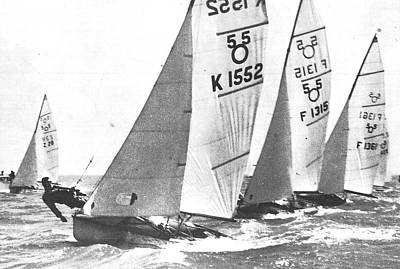IRISH BALLAD 1964
from
the
International 505 Class Magazine -1965
This year 93 boats
took part in the World 505 Championship held in Cork (Ireland).
56 were English, 25 Irish, 7 French, 1 Swiss, 1 Australian, and 3 Swedish.
THE 505 IS GOING FROM STRENGTH TO STRENGTH
 We are, of course, all aware of the technical improvements embodied in the new 505's, which have brought about a definite increase in their speed. But there is a more important consideration. 40 boats sailed at Bendor, 52 took part in the "La Rochelle Week", 60 in the French Championship, but more than 100 entered for the World Championship.
We are, of course, all aware of the technical improvements embodied in the new 505's, which have brought about a definite increase in their speed. But there is a more important consideration. 40 boats sailed at Bendor, 52 took part in the "La Rochelle Week", 60 in the French Championship, but more than 100 entered for the World Championship.
But for last minute transport difficulties, the French team would have been much larger, and consequently the total number of competitors would also have been greater. In spite of everything, 7 boats set out for Cork: the Bosle-Gaillard team by road, the others on the 28,000 ton Cunarder "Carmania".
The young ambitious team on the "Carmania" included: Haegli-Mani�re; Briand-Fournier; Draeger-DeBarneville; the Tenon brothers; Billot-Rousseau and Goutard-Ruellan, accompanied by Monique Baudry, Secretary of the "505 Class", always to be found at her post, and by Maurice Battaglini, an official judge and a faithful follower of the team, who endeavoured to make good order the watchword for a lively group. Nor must we forget the continual help given by Madame Draeger, who leapt to the assistance of anyone (some perhaps more than others) who got bogged down in the difficulties of the English language.
The sea was as calm as a mill-pond, and the crossing on the "Carmania" seemed over too soon for many of us. When the Irish coast emerged from the mists, there were quite a number who would have liked to sail on to Canada.
The 505's were unloaded from the liner in Cork Bay, and although the operation went off remarkably well, thanks to Cunard's careful handling, certain eminent members of the team were absent during unloading, evidently preferring not to be on the scene at the tense moment when mastheads were swaying between sea and sky at a height of 90 feet.
After Customs formalities at Cobe at about 11 pm., the 505's were uncovered and put in the water. A Club launch lead the fleet through amaze of dusk shrouded islands, and half an hour later we arrived at the Royal Munster Yacht Club, situated in the depths of a fjord, near the little resort of Crosshaven.
In all honesty it must be admitted that this latter part of the voyage seemed chilly and uncomfortable to the members of our team, tired as they were from ...the previous night spent in the Cabaret on the "Carmania".
But our flagging keenness was instantly renewed by the welcome (Irish Coffee) given us by our Irish
hosts.
This country, though not one of the richest, worked wonders in preparing for the Championship, even making excavations in the hills so as to accommodate the caravans which were hired to some of the competitors.
But above all we must single out for mention the spirit reigning at the Club, where no stone was left unturned to make our stay a congenial one.
A team was on hand to ensure the proper functioning of the slipway, and operated it excellently, despite of its obvious inadequacy.
Each day at noon, meals were prepared and served to 250 people by the wives of Club Members.
Finally, the impressive number of boats following the races demonstrated the interest aroused by the event, and enabled the return to be made in groups of 10, once the 505's had reached the finishing post.
The Press had also made a great effort. Every morning, special editions, distributed free of charge, provided 4 to 5 pages of photos and commentaries on the previous day's racing.
Even more astonishingly the winner of a heat who crossed the finishing line at 12-30 pm was able to read an account of his race in the 5 pm edition of the main Irish evening newspaper.
The Championship, which went off without a single hitch, ended with a prizegiving in which the first ten crews received magnificent mementoes, and, in accordance with British custom, the first three also received cups.
Next day, the French team split up again; one group returning to Paris by plane, the other, together with the 505's and the "Waltzing Matilda ", the new World Champion, travelling on the "New Amsterdam", a luxurious 38,000 ton liner, whose service and cuisine delighted the hearts of our
passengers.
Others will write about the sporting angle. However, we must say how much we were impressed by the simplicity and the solidity of the British boats.
We have very fine shipbuilders in France, but it seems to us that they are influenced by the "gadget" mania which affects so many French racers. On the other hand, although the Australians, about whom we knew nothing before Larchmont, had the field to themselves in 1963, it is our belief, and they themselves are willing to admit it, that Europe has assimilated their technique and made up the lost ground, which is a splendid result.
But let us not make the mistake of resting on our laurels; even though modern boat-building has to mark time for the moment, there is always room for improvement in crewing technique.
By A. DRAEGER, No. 1717